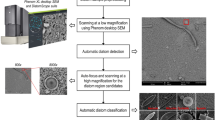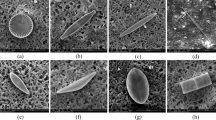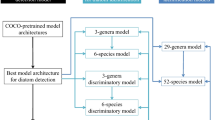Abstract
Seasonal or monthly databases of the diatom populations in specific bodies of water are needed to infer the drowning site of a drowned body. However, existing diatom testing methods are laborious, time-consuming, and costly and usually require specific expertise. In this study, we developed an artificial intelligence (AI)-based system as a substitute for manual morphological examination capable of identifying and classifying diatoms at the species level. Within two days, the system collected information on diatom profiles in the Huangpu and Suzhou Rivers of Shanghai, China. In an animal experiment, the similarities of diatom profiles between lung tissues and water samples were evaluated through a modified Jensen-Shannon (JS) divergence measure for drowning site inference, reaching a prediction accuracy of 92.31%. Considering its high efficiency and simplicity, our proposed method is believed to be more applicable than existing methods for seasonal or monthly water monitoring of diatom populations from sections of interconnected rivers, which would help police narrow the investigation scope to confirm the identity of an immersed body.







Similar content being viewed by others
References
Guiry MD (2012) How many species of algae are there? J Phycol 48:1057–1063. https://doi.org/10.1111/j.1529-8817.2012.01222.x
Mann DG, Vanormelingen P (2013) An inordinate fondness? The number, distributions, and origins of diatom species. J Eukaryot Microbiol 60:414–420. https://doi.org/10.1111/jeu.12047
Barlow N (2011) The diatoms: applications for the environmental and earth sciences. Quat Sci Rev 30:1011. https://doi.org/10.1016/j.quascirev.2011.01.014
Round F, Crawford R, Mann D (1991) The diatoms: biology and morphology of the genera. Taxon 40:156. https://doi.org/10.2307/1222958
Ludes B, Coste M, North N, Doray S, Tracqui A, Kintz P (1999) Diatom analysis in victim's tissues as an indicator of the site of drowning. Int J Legal Med 112:163–166. https://doi.org/10.1007/s004140050224
Carballeira R, Vieira DN, Febrero-Bande M, Muñoz Barús JI (2018) A valid method to determine the site of drowning. Int J Legal Med 132:487–497. https://doi.org/10.1007/s00414-017-1708-1
Ludes B, Coste M, Tracqui A, Mangin P (1996) Continuous river monitoring of the diatoms in the diagnosis of drowning. J Forensic Sci 41:425–428
Coelho S, Ramos P, Ribeiro C, Marques J, Santos A (2016) Contribution to the determination of the place of death by drowning - a study of diatoms' biodiversity in Douro river estuary. J Forensic Legal Med 41:58–64. https://doi.org/10.1016/j.jflm.2016.04.007
Deng J, Dong W, Socher R, Li L-J, Li K, Li FF (2009) ImageNet: a large-scale hierarchical image database
Kermany DS, Goldbaum M, Cai W et al (2018) Identifying medical diagnoses and treatable diseases by image-based deep learning. Cell 172:1122–31.e9. https://doi.org/10.1016/j.cell.2018.02.010
Coudray N, Ocampo PS, Sakellaropoulos T, Narula N, Snuderl M, Fenyö D, Moreira AL, Razavian N, Tsirigos A (2018) Classification and mutation prediction from non-small cell lung cancer histopathology images using deep learning. Nat Med 24:1559–1567. https://doi.org/10.1038/s41591-018-0177-5
Cruz-Roa A, Gilmore H, Basavanhally A, Feldman M, Ganesan S, Shih NNC, Tomaszewski J, González FA, Madabhushi A (2017) Accurate and reproducible invasive breast cancer detection in whole-slide images: a deep learning approach for quantifying tumor extent. Sci Rep 7:46450. https://doi.org/10.1038/srep46450
Zhou Y, Zhang J, Huang J, Deng K, Zhang J, Qin Z, Wang Z, Zhang X, Tuo Y, Chen L, Chen Y, Huang P (2019) Digital whole-slide image analysis for automated diatom test in forensic cases of drowning using a convolutional neural network algorithm. Forensic Sci Int 302:109922. https://doi.org/10.1016/j.forsciint.2019.109922
Pedraza A, Bueno G, Deniz O, Cristobal G, Blanco S, Borrego-Ramos M (2017) Automated diatom classification (part B): a deep learning approach. Appl Sci 7:460. https://doi.org/10.3390/app7050460
Rs R, Cogswell M, Das A, Vedantam R, Parikh D, Batra D (2019) Grad-CAM: visual explanations from deep networks via gradient-based localization. Int J Comput Vis 128. https://doi.org/10.1007/s11263-019-01228-7
Hürlimann J, Feer P, Elber F, Niederberger K, Dirnhofer R, Wyler D (2000) Diatom detection in the diagnosis of death by drowning. Int J Legal Med 114:6–14. https://doi.org/10.1007/s004149900122
Auer A (1991) Qualitative diatom analysis as a tool to diagnose drowning. Am J Forensic Med Pathol 12:213–218. https://doi.org/10.1097/00000433-199109000-00009
Hayakawa A, Terazawa K, Matoba K, Horioka K, Fukunaga T (2017) Diagnosis of drowning: electrolytes and total protein in sphenoid sinus liquid. Forensic Sci Int 273:102–105. https://doi.org/10.1016/j.forsciint.2017.02.017
Sidari L, Di Nunno N, Costantinides F, Melato M (1999) Diatom test with Soluene-350 to diagnose drowning in sea water. Forensic Sci Int 103:61–65. https://doi.org/10.1016/s0379-0738(99)00056-0
Singh R, Singh R, Thakar M (2006) Extraction method of diatoms-a review. Indian Internet J Forensic Med Toxicol 4
Funayama M, Aoki Y, Sebetan IM, Sagisaka K (1987) Detection of diatoms in blood by a combination of membrane filtering and chemical digestion. Forensic Sci Int 34:175–182. https://doi.org/10.1016/0379-0738(87)90071-5
Seo Y, Sato S, Kuroki K, Kishida T (2013) A simple DNA coprecipitation method for the detection of diatoms in heart blood. Forensic Sci Int 232:154–159. https://doi.org/10.1016/j.forsciint.2013.07.016
Hu S, Liu C, Wen J, Dai W, Wang S, Su HF, Zhao J (2013) Detection of diatoms in water and tissues by combination of microwave digestion, vacuum filtration and scanning electron microscopy. Forensic Sci Int 226:e48–e51. https://doi.org/10.1016/j.forsciint.2013.01.010
Zimmermann J, Jahn R, Gemeinholzer B (2011) Barcoding diatoms: evaluation of the V4 subregion on the 18S rRNA gene, including new primers and protocols. Org Divers Evol 11:173–192. https://doi.org/10.1007/s13127-011-0050-6
Evans K, Wortley A, Mann D (2007) An assessment of potential diatom "barcode" genes (cox1, rbcL, 18S and ITS rDNA) and their effectiveness in determining relationships in Sellaphora (Bacillariophyta). Protist 158:349–364. https://doi.org/10.1016/j.protis.2007.04.001
Moniz M, Kaczmarska I (2009) Barcoding of diatoms: nuclear encoded ITS revisited. Protist 161:7–34. https://doi.org/10.1016/j.protis.2009.07.001
Mann D, Sato S, Trobajo R, Vanormelingen P, Souffreau C (2010) DNA barcoding for species identification and discovery in diatoms. Cryptogam Algol 31:557–577
Zhao Y, Chen X, Yang Y, Zhao X, Zhang S, Gao Z, Fang T, Wang Y, Zhang J (2018) Potential forensic biogeographic application of diatom colony consistency analysis employing pyrosequencing profiles of the 18S rDNA V7 region. Int J Legal Med 132:1611–1620. https://doi.org/10.1007/s00414-018-1849-x
Li Z, Liu X, Yu Y, Huang H, Li X, Ji Q, Li K, Yu Y, Li D, Mao Z, Pu Y, Chen P, Chen F (2019) Barcoding for diatoms in the Yangtze River from the morphological observation and 18S rDNA polymorphic analysis. Forensic Sci Int 297:81–89. https://doi.org/10.1016/j.forsciint.2019.01.028
Athanasiadou E, Geradts Z, Eijk VE (2018) Camera recognition with deep learning. Forensic Sci Res 3:210–218. https://doi.org/10.1080/20961790.2018.1485198
Fydanaki A, Geradts Z (2018) Evaluating OpenFace: an open-source automatic facial comparison algorithm for forensics. Forensic Sci Res 3:202–209. https://doi.org/10.1080/20961790.2018.1523703
Zhou YY, Cao YJ, Huang J, Deng KF, Ma KJ, Zhang TY, Chen LQ, Zhang J, Huang P (2020) Research advances in forensic diatom testing. Forensic Sci Res 5:98–105
Funding
This work is supported by the Natural Science Foundation of China (Nos. 81801873, 81722027, and 81671869), grants from the Ministry of Finance (No. GY2020G-2), the Science and Technology Committee of Shanghai Municipality (Nos. 17DZ2273200 and 19DZ2292700), and Shanghai Key Laboratory of Forensic Medicine [KF1802].
Author information
Authors and Affiliations
Corresponding authors
Ethics declarations
Conflict of interest
The authors declare that they have no conflict of interest.
Additional information
Publisher’s note
Springer Nature remains neutral with regard to jurisdictional claims in published maps and institutional affiliations.
Rights and permissions
About this article
Cite this article
Zhang, J., Zhou, Y., Vieira, D.N. et al. An efficient method for building a database of diatom populations for drowning site inference using a deep learning algorithm. Int J Legal Med 135, 817–827 (2021). https://doi.org/10.1007/s00414-020-02497-5
Received:
Accepted:
Published:
Issue Date:
DOI: https://doi.org/10.1007/s00414-020-02497-5




